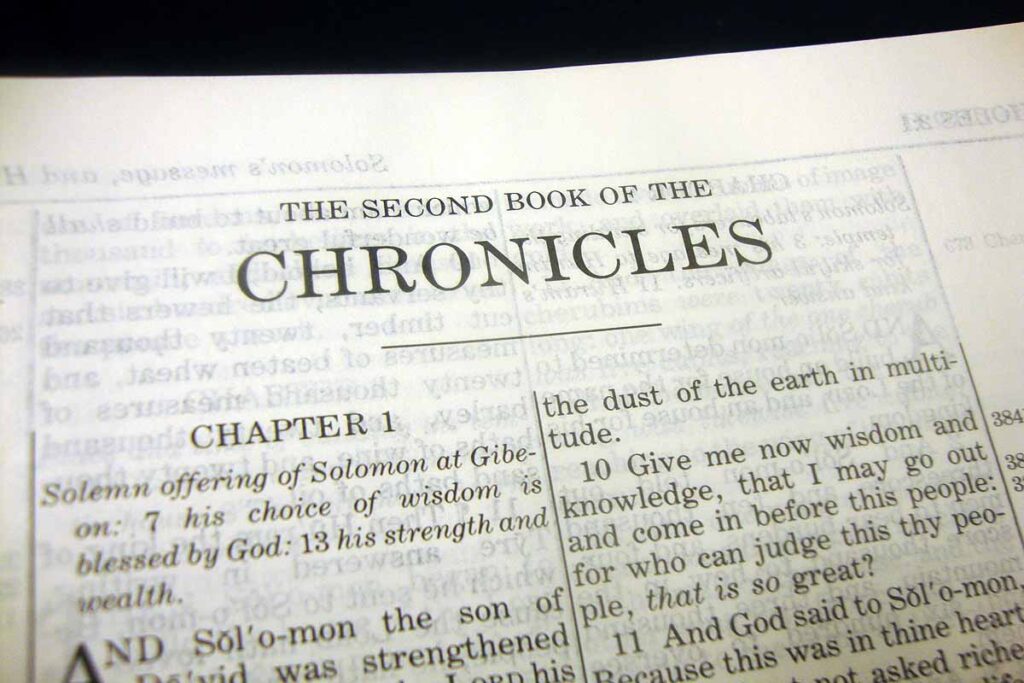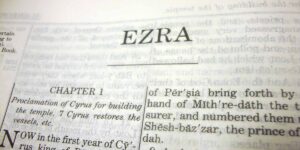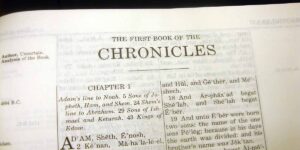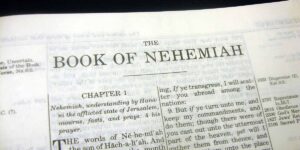Second Chronicles
Second Chronicles continues the history of First Chronicles. David’s son, Solomon, was inaugurated as king. Solomon built the magnificent temple in Jerusalem, thus fulfilling his father’s wish and last request. Solomon enjoyed a peaceful and prosperous reign of 40 years that made him world-famous. After Solomon dies, his son Rehoboam assumed the throne, and his immaturity divided the kingdom.
Solomon achieved much in business and government, but most importantly, he was the man God used to build the glorious temple. This beautiful building was the religious center of the nation. It symbolized the unity of all the tribes, the presence of God among them, and the nation’s high calling. We may achieve great things in life, but we must not neglect any effort that will help nurture God’s people or bring others into God’s kingdom. It is easy for us to get the wrong perspective on what’s really important in life.
Throughout the reigns of 20 kings, the nation of Judah wavered between obedience to God and apostasy. The reigning king’s response to God determined the spiritual climate of the nation and whether or not God would send judgment upon his people. Our personal history is shaped by our response to God. Just as Judah’s failure to repent brought them captivity in Babylon, so the abuse of our high calling by sinful living will ultimately bring us catastrophe and destruction.
As you read Second Chronicles, listen to God’s voice and obey him; and receive his redemptive, healing touch.
Writer of Second Chronicles
Ezra is the most likely candidate for the authorship of First and Second Chronicles. The early Jewish tradition of the Talmud affirms that Ezra wrote First and Second Chronicles. The last verses of 2 Chronicles are repeated in the first three verses of the book of Ezra (originally written with Nehemiah as one book), probably indicating they went together in the original version. Most scholars agree that these four books were written and compiled by the same person, but not all accept the theory of Ezra’s authorship.
Date Written
Approximately 430 B.C. recording events from the beginning of Solomon’s reign (970 B.C.) to the beginning of the Babylonian captivity (586 B.C.).
Historical Setting of Second Chronicles
The books of First Chronicles and Second Chronicles cover several centuries of the history of God’s covenant people – from the founders of the nation until the end of their captivity in Babylon and Persia about 538 B.C. The stage is set for the return of the Jewish people to Jerusalem after the Persians defeat Babylon and become the dominant power of the ancient world.
Theological Contribution
The books of First Chronicles and Second Chronicles should not only be read as histories but for their insights into how God has kept faith with His covenant people across the centuries. By selecting events that show God has kept His promises, the author presents a beautiful doctrine of hope that begins with Adam and stretches to the end of the captivity of God’s people thousands of years later. The clear implication for Christians today is that He is still a God of hope whose ultimate purpose will prevail in the world and in the lives of His people.
Recommended Bible Study Resources
ESV Study Bible – Study Bibles give you a deeper understanding of God’s Word with tools for life application like commentary, maps, charts, concordance, and study notes. Search our popular translations- NIV, ESV, NKJV, KJV and more!
Believer’s Bible Commentary: Second Edition – A Bible commentary is a written, systematic series of explanations and interpretations of Scripture. Commentaries often analyze or expound on individual books of the Bible, chapter by chapter and verse by verse. Some commentary works provide analysis of the whole of Scripture.
The New Strong’s Expanded Exhaustive Concordance of the Bible – The best concordance for word study! This exclusive new edition of a legendary classic puts generations of biblical research at your fingertips. A valuable tool for pastors, teachers, and students of the Bible.
Vine’s Complete Expository Dictionary of Old and New Testament Words – This classic word study resource allows you to study the meaning of biblical words in the original languages without spending years learning Greek or Hebrew. A great resource for students, seasoned pastors, and anyone who enjoys biblical word studies–even if they have little to no formal training in Hebrew or Greek.
Halley’s Bible Handbook – The beloved and classic Bible companion has been thoroughly updated, while retaining its time-honored features and Dr. Halley’s highly personal style, to offer even greater clarity, insight, and usefulness.
Click here to download or print the Bible outline “Second Chronicles – Humble Seek Pray“






